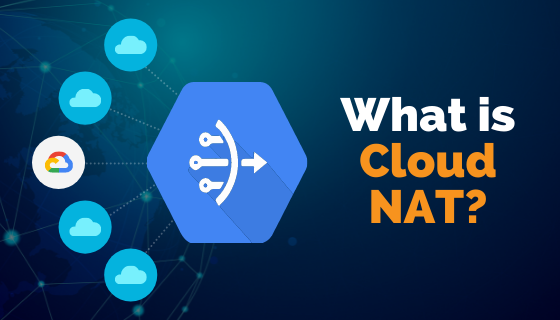Cloud NAT is a Network Address Translation System that works in close association with the Google Cloud Platform. The system works towards connecting certain external resources to connect to the internet without any specific public IP address. The Cloud NAT system works under some conditions and prerequisites. By using the Cloud NAT system, you can connect with the Internet via GCP even if you do not own a GCP-specific public IP address.
These outbound connections come in handy in multiple projects and applications. Since the internet is a fundamental need for all kinds of applications and sites today, Cloud NAT comes in use for many IT applications. However, Cloud NAT does not support inbound connections to the internet via GCP.
Interested in Google Cloud Certifications? Check out Whizlabs online courses, practice tests, and free test here!
In this article, we elaborate on the basic architecture and specifications of Cloud NAT before going into its prerequisites and setup. In this article, we discover everything beyond the basic definition of Cloud NAT. We will understand how Cloud NAT helps in providing private apps and systems internet connectivity without compromising their privacy status and overall data security.
Overview of Cloud NAT usage and applications
Cloud NAT is a multi-faceted Google Cloud program that extends many functions to the system it connects to. Cloud NAT is very specific to which resources it connects and provides outbound internet connectivity. For example, it supports the functions of a virtual machine with a computing engine even if it lacks an external IP address. It also extends connectivity to Private GKE clusters present on the GCP. These GKE clusters might lack an external IP address but still run on the GCP with the help of Cloud NAT.
On the other hand, Cloud NAT offers VPC servers less access to Cloud run and Cloud Function interfaces. The system also supports App Engine standard environment setups with outbound connections and VPC serverless access. Thus, Cloud NAT supports accessibility and network connectivity of digital systems and applications through the Google Cloud Platform
Cloud NAT architecture
The main characteristic of the Cloud NAT system is that it is powered by a distributed cluster of software. Instead of depending on bulky, inefficient hardware and Virtual machines, the Cloud NAT system works on a distributed cluster of cloud software on GCP. The Cloud NAT system configures and connects with the Andromeda software to create a Virtual Private Cloud Network for applications.
The setup of Cloud NAT and Andromeda then assign SNATs or Source Network Address Translation for virtual machines and applications. While Cloud NAT does not provide inbound connections to applications without external IP addresses, it does provide Destination Network Address Translation code to inbound packets.
Preparing for Google Cloud Certified Professional Cloud Network Engineer? Try Whizlabs Free Test today!
The difference between not allowing inbound connectivity and letting inbound packets pass through the gateway is that Cloud NAT allows only those inbound response packets that come in response to any prior outbound activity on the already connected application. Thus, the NAT gateway acts as a selective gateway for inbound packets and assigns DNATs to them.
The outbound connectivity on Cloud NAT works along with static routes of your VPC network, and data runs through the default internet gateway.
Organizational security through Cloud NAT policy
The primary benefits of using Cloud NAT are network connectivity and security. To support the use of a private network, Cloud NAT allows network administrators to configure certain organization policies. By setting up an organizational policy, you can introduce some constraints on the accessibility of your private network.
Learn more about Cloud Functions!
A network administrator has the authority to set up subnetworks linked with the main NAT gateway. A network administrator can create as many subnets as he or she wants. Also, at first, there are no restrictions on which subnet can use the gateway. However, by activating an Organization Policy administrator, the constraints can be used to decide which subnets can access the NAT gateway at a given time.
The Prerequisites of NAT Organizational Policy
There are certain prerequisites to fulfill for an Organization Policy administrator before successfully setting up constraints on the NAT Gateway. The prerequisites are as follows:
-
IAM permissions
The person has to have proper permissions on the GCP from the roles/or policy.policy admin role. Even when the policy administrator is using a shared VPC, he should be part of the host project.
-
Thorough organizational policy knowledge
You need to know about Organization Policy in detail so that you have enough clarity on how to set up the constraints.
-
Plan the constraints setup
Once you are clear on what constraints are and how they come into the organization’s policy, you need to plan the constraints. You have to be mindful of the resources you have and how to use them. In the resources, you have Organization, Folder, project, and subnetwork. While assigning constraints, you need to be mindful of the resource hierarchy while setting up the constraints. You need to remember that constraints do not directly restrict subnets from accessing the gateway. Instead, constraints work on possible configurations that would eventually violate them.
How to set up NAT IP address?
The application connected to the Cloud NAT lacks an external IP address. So, the system needs an external IP address that can fill in. A NAT IP address is a regional external IP address that connects to an internet route. Any subnet that connects with the NAT gateway for internet connectivity uses a NAT IP address to locate and send data packets to a certain destination.
Here are the two main ways in which you can assign NAT IP addresses to your Cloud NAT gateway.
-
Automatic Allocations
The option to start automatic allocations of IP address is at the Google Cloud Default settings. You can choose this option to allow your Cloud NAT gateway to add NAT IP addresses to your subnets based on the VMS that uses the gateway. The number of NAT IP addresses also depends on the number of ports reserved for each VM.
These NAT IP addresses come through as static regional IP addresses and are listed under the same heading in the interface. Because the entire allocation process is taken over by the gateway, the user will be unable to estimate the number of allocated NAT IP addresses. If you want to exercise greater user control on the allocation process, you should opt for manual allocation.
Must read: A Guide to GKE Clusters!
On the other hand, the NAT gateway deallocates an IP address when it is no longer in use by any VM on the network. This means that when any VM on the network detaches from its port, its assigned NAT IP address also no longer exists. However, as long as the IP address is in use by at least one VM, it stays active and in use. Then, the IP address can allocate with newer VMs.
-
Manual NAT allocation
When you choose the option of manual NAT IP address allocation, you get to create individual static IP addresses and assign them to specific VMs on the gateway. You have greater control over the NAT IP address creation and allocation. You limit the number of NAT IP addresses in circulation by editing the configuration of the NAT Gateway.
However, the only thing that needs your attention is the estimated number of NAT IP addresses needed. You have to estimate the NAT IP addresses needed for the gateway function. You then create the exact number of NAT IP addresses. This is necessary because if the gateway runs out of IP addresses, connectivity is hampered, and the system drops data packets before they can go into the gateway. Thus, your calculations have to be exact. Otherwise, it is always better to go for automatic allocation.
Read more about Google App Engine!
The switch between the automatic and manual methods of allocation does not preserve your IP addresses. Once you switch, the previous static addresses get deleted.
How to set up Cloud NAT?
Before you set up your Cloud NAT gateway, you need some prerequisites that fulfill the needs of setup. The prerequisites of the setup process are as follows-
Prerequisites of NAT gateway setup
- You need to hold the admin role on the network to have the permissions to create a NAT gateway for the VMs. The role of an admin is to initiate the NAT gateway through the Cloud Router. The admin also takes the lead in reserving and assigning NAT IP addresses so that subnets are properly assigned on the gateway.
- The second thing that you need is a Google Cloud account and an introduction to GCP and its services. If you do not have a Google Cloud Account, you need to start one by signing into Google.
- Then you need to access the Google Cloud Console and start a GC project.
- After this, you enable billing for your project. Once this is done, the fourth step is to install and set up Cloud SDK so that you gain all the tools needed to use Google Cloud Services properly.
- Before going into NAT gateway setup, you need to set up your project ID by using the Project ID command line.
Creating a NAT Gateway
You can start a simple configuration pretty easily using the GCP. For example, you turn on automatic allocation for subnets through simple configuration. After this, each VM on each subnet is assigned external IP addresses without much manual intervention. The IP addresses get assigned automatically and count on the static IP address quota. There are two main ways of creating NAT gateways. One is through Console, and the other is through gcloud.
Console method
- On the Console, go to the Cloud NAT page.
- Then click get started or Create NAT Gateway to start creating,
- Enter a gateway name and choose a VPC network to give the gateway some specifications.
- Set the region of an operation via the Region option.
- Select or create a Cloud Router specific to the region mentioned.
- Click on logging, minimum ports, and time out to open the log section.
- The stack driver logging section will open, from which you can select Translation and errors. This will enable Cloud Logging for the gateway.
- After this, click on Create to create the NAT gateway.
Gcloud method
The gcloud method is also simple to use for NAT Gateway setup. The steps of setting up the NAT Gateway through gcloud are:
- Access the gcloud compute routers via the NAT_CONFIG command. You then specify the name of your NAT gateway.
- Specify the cloud router through the NAT_ROUTER command. This specifies the name of your cloud router.
- Then you choose the automatic allocating command by specifying the auto-allocate-nat-external-ips
- After this, all the subnets are specified by using the nat-all-subnet-ip-ranges
- At last, you enable cloud logging of the gateway by enable-logging command.
These are the various ways of creating a NAT gateway. The GCP-powered Cloud NAT gateway is preferred by organizations because it promises high performance and maintains standards of security as well as uninterrupted connectivity. If you have access to GCP and are well acquainted with Google Cloud Services, you can easily set up a NAT gateway for your private projects and applications. The Cloud NAT platform scales up and down as per your project size and requirements, enabling higher accessibility and convenience.
Bottom Line
When you use Cloud NAT, you are doing so via an external IP address. Since you lack a public IP address, your system is not prone to unauthorized access, but you still get high internet connectivity to run computer-intensive operations. So, the Cloud NAT gateway keeps your application secure and private even with internet connectivity.
Cloud NAT offers a high-performance Network Address Translation service using which a system can be configured and optimized. Whether you run troubleshooting programs on it or access the internet for intensive operations, the security and performance of the connected application do not get affected. Moreover, Cloud NAT is designed in a way that it supports both Compute Engine and GKE clusters.
Read more on Google Compute Engine!
Thus, it has a multi-faceted user interface and offers versatility in its operations. Even when your application has fluctuating workload, Cloud NAT supports it with full efficiency. The entire architecture of Cloud NAT is scalable and flexible that supports multiple NAT IP address on one gateway. Whether you connect to a small network or a branched complex one, Cloud NAT supports security and connectivity of it seamlessly.
- Cloud DNS – A Complete Guide - December 15, 2021
- Google Compute Engine: Features and Advantages - December 14, 2021
- What is Cloud Run? - December 13, 2021
- What is Cloud Load Balancing? A Complete Guide - December 9, 2021
- What is a BigTable? - December 8, 2021
- Docker Image creation – Everything You Should Know! - November 25, 2021
- What is BigQuery? - November 19, 2021
- Docker Architecture in Detail - October 6, 2021



